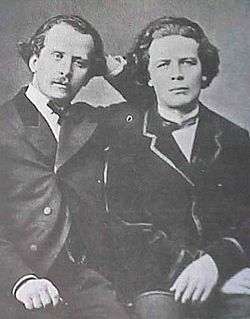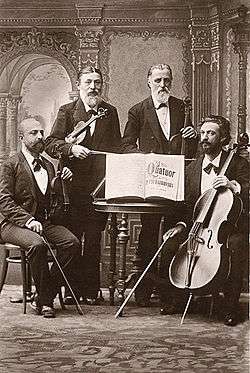Russian Musical Society

The Russian Musical Society (RMS) (Russian: Русское музыкальное общество) was an organisation founded in 1859 by the Grand Duchess Elena Pavlovna (a German-born aunt of Tsar Alexander II) and her protégé, pianist and composer Anton Rubinstein, with the intent of raising the standard of music in the country and disseminating musical education.[1]
Rubinstein and the Grand Duchess's travels together in Europe a decade earlier had prompted them to set up a permanent society to encourage both the study and performance of music in Russia. The Grand Duchess was the provider and driving force for the RMS, successfully obtaining her nephew's Imperial approval.[2] Rubinstein provided the musical leadership. His presence lent the RMS a further appearance of prestige, given both his international career as a pianist and his reputation as a composer of distinction—qualities uncommon at that time for any native-born musician in Russia.[3]
The RMS's inaugural concert was given in November 1859, with Rubinstein playing one of his piano concertos.[4] By the mid-1860s, concerts given by the RMS had introduced the general public to all the symphonies, piano concertos and overtures of Ludwig van Beethoven. Audiences had also heard oratorios by George Frideric Handel, cantatas by Johann Sebastian Bach, operas by Christoph Willibald Gluck, as well as works by Robert Schumann and Franz Schubert. Russian music had also been performed. Operas by Russian composers which were presented included those of Mikhail Glinka, Alexander Dargomyzhsky and Anton Rubinstein, among others.[5]

Most important, however, were the music classes offered by the RMS, open to all students, which eventually gave rise to professorial education.[6] These classes were held at the Grand Duchess's home, the Mikhailovsky Palace.[7]
Until the inception of the RMS, there had been no music school in Russia to provide a basic professional training in music. Music instruction had been limited to the homes of the aristocracy and private schools. Consequently, native Russian musicians and performers were rare. Classical concerts were performed generally by foreign musicians, primarily from Germany.[8]
In addition to the classes of the RMS, the Free Music School, which emphasised choral singing, was also formed. Both the classes and the school quickly became popular. As surprising as the number of students who enrolled was their extreme diversity. Bureaucrats, merchants, tradesmen and university students attended, as well as many young women who lacked the means to study privately.[6]
In 1860, helped and encouraged by his brother Anton, Nikolai Rubinstein and Prince Nikolai Petrovitch Troubetzkoy founded a Moscow branch of the RMS in Rubinstein's own house. This branch proved so successful that they eventually relocated it into larger quarters and expanded their work there.[9] Troubetzkoy was the chairman of RMS for seventeen years.
The RMS's formal successors were the St. Petersburg Conservatory, which opened (also under the auspices of Anton Rubinstein), in September 1862, and the Moscow Conservatory, founded by Nikolai Rubinstein and Prince Nikolai Petrovitch Troubetzkoy in September 1866.
The society was disbanded in 1917.
References
- ↑ Warrack, John, Tchaikovsky (New York: Charles Scribner's Sons, 1973), 36
- ↑ Struttle, Wilson, Tchaikovsky, His Music and Times (Speldhurst, Kent, United Kingdom: Midas Books, 1979), 11-12
- ↑ Brown, David, Tchaikovsky: The Early Years, 1840-1874 (New York: W.W. Norton & Company, Inc., 1978), 59-60
- ↑ Brown, 60
- ↑ Poznansky, Alexander, Tchaikovsky: The Quest for the Inner Man (New York: Schirmer Books, 1991), p.62
- 1 2 Poznansky, 62
- ↑ Brown, 60; Strutte, 12
- ↑ Brown, 60; Poznansky, 62
- ↑ Warrack, 42
Sources
- Brown, David, Tchaikovsky: The Early Years, 1840-1874 (New York: W.W. Norton & Company, Inc., 1978)
- Poznansky, Alexander, Tchaikovsky: The Quest for the Inner Man (New York: Schirmer Books, 1991)
- Struttle, Wilson, Tchaikovsky, His Music and Times (Speldhurst, Kent, United Kingdom: Midas Books, 1979)
- Warrack, John, Tchaikovsky (New York: Charles Scribner's Sons, 1973)